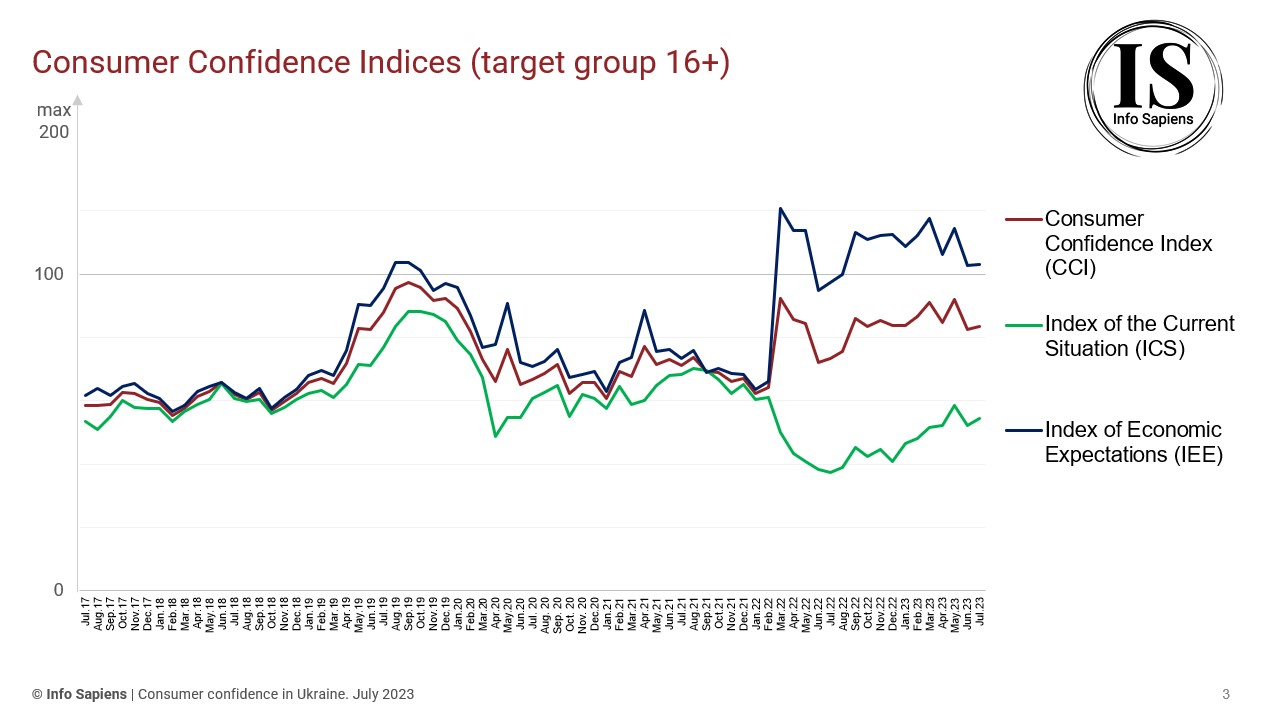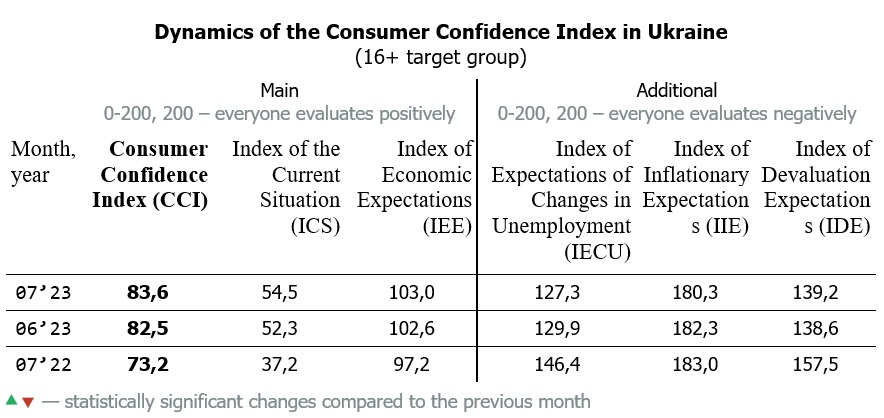According to the data provided by Info Sapiens “Consumer confidence of Ukrainians” in July, 2023, the Consumer Confidence Index of Ukrainians has increased by 1,1 points and equals 83,6 points.
Index of the Current Situation (ICS) have increased and equals 54,5, which is 2,2 p. higher than in June. The components of this index have changed as follows:
Index of the Current Situation (ICS) have decreased and equals 52,3, which is 6,1 p. lower than in May. The components of this index have changed as follows:
- – Index of Current Personal Financial Standing (х1) equals 48,1, which is 0,8 points higher than the indicator in June;
- – Index of Propensity to Consume (х5) increased by 3,6 p. to the level 60,9 p.
In July, Index of Economic Expectations (ІЕE) increased by 0,4 p. and equals 103 p. The components of this index have changed as follows:
- – Index of Expected Changes in Personal Financial Standing (х2) equals 96,3 p., which is 0,1 points lower than in June;
- – Index of Expectations of the Country’s Economic Development Over the Next Year (х3) in July equals 87 p., which is 0,3 points lower than in previous month;
- – Index of Expectations of the Country’s Economic Development over the Next 5 Years (х4) increased by 1,5 points compared to last month and equals 125,6 p.
In July, the indicator of Index of Expectations of Changes in Unemployment has decreased by 2,6 points and equals 127,3 p. Index of Inflationary Expectations decreased by 1,9 points and equals 180,3 p. Expectations of Ukrainians regarding the hryvna’s exchange rate in the coming three months have some worsened: Index of Devaluation Expectations increased by 0,6 p. and equals 139,2 p.
«In July 2023, following a notable reduction in metrics across all components of index last month, we observe a stabilization of the situation and even a slight increase in most indicators. Throughout July, slight advancements were noted in both Consumer Confidence Index (CCI) and the indices pertaining to the present situation and economic expectations. This could suggest a period of cautious anticipation among the population. We continue to monitor the situation and evaluate the dynamics only on extended time spans.» - as Info Sapiens analysts comment.


Survey information
The study of the Consumer Confidence Index in Ukraine was conducted by GFK UKRAINE since June 2000, and since 2019 it has been carried out by INFO SAPIENS LLC.
In Ukraine, the Consumer Confidence Index is determined through a random survey of domestic households. During the poll, 1,000 people aged 16 and over are interviewed. The structure of the sample corresponds to the structure of the population according to such parameters as gender, age, size of the settlement, and region according to the latest available data of the State Statistics Service of Ukraine before the full-scale invasion of russia on February 24, 2022. The "Consumer Confidence" study is not conducted in the Autonomous Republic of Crimea, the city of Sevastopol, as well as other territories of Ukraine temporarily occupied by russia, where Ukrainian operators do not provide mobile phone services. Also, the survey does not include Ukrainians who went abroad. The margin of error does not exceed 3.1%. In April and May 2020, as well as in April 2021, due to COVID-19, and from March 2022, the survey was conducted by telephone interview with calls to mobile numbers. Dates of the latest survey: July 7-17.
To define the CCI, respondents are asked these questions:
- 1. How has the financial standing of your family changed over the last six months?
- 2. How do you think your family’s financial standing will change in the next six months?
- 3. Looking at economic conditions in the country as a whole, do you think the next 12 months will be good or bad?
- 4. Looking at the next five years, will they be good ones or bad ones for the country’s economy?
- 5. In terms of large purchases for your home, do you think now is generally a good time or a bad time to make such purchases?
- • index of Current Personal Financial Standing (x1);
- • index of Expected Changes in Personal Financial Standing (x2);
- • index of Expected Economic Conditions in the Country Over the Next Year (x3);
- • index of Expected Economic Conditions in the Country Over the Next 5 Years (x4);
- • index of Propensity to Consume (x5).
- • consumer Confidence Index (CCI) as the arithmetic average of indices x1–x5;
- • index of the Current Situation (ICS) as the arithmetic average of indices x1 and x5;
- • index of Economic Expectations (IEE) as the arithmetic average of indices x2, x3, and x4.
- 1. Do you think that within next 12 months the number of unemployed (people who do not have job and are looking for work) will increase, will remain roughly the same, or will decrease?
- 2. How do you think that prices for major consumer goods and services will change in the next 1–2 months?
- 3. How do you think the USD value will change towards the UAH value during the next 3 months?
Each of these questions is related to a corresponding index:
Indices are constructed thus: the share of negative answers is deducted from the share of positive answers, and 100 is added to this difference in order to eliminate negative values. On the basis of these five indices, three aggregate indices are calculated:
Index values range from 0 to 200. The index equals 200 when all respondents positively assess the economic situation. It totals 100 when the shares of positive and negative assessments are equal. Indices of less than 100 indicate the prevalence of negative assessments. To determine the Index of Expected Changes in Unemployment (IECU), the Index of Inflationary Expectations (IIE) and the Index of Devaluation Expectations (IDE), the respondents are asked these three questions:
The IECU, the IIE and the IDE are calculated thus: the share of answers that indicate a decrease of unemployment/inflation/devaluation is subtracted from the share of answers that indicate the growth of unemployment/inflation/devaluation, and 100 is added to the difference to eliminate negative values. The values of indices can vary from 0 to 200. The index totals 200 when all residents expect an increase in unemployment/inflation/devaluation.
